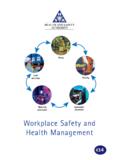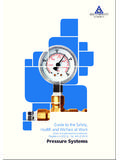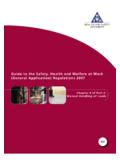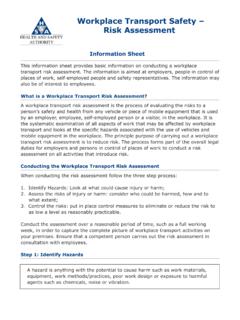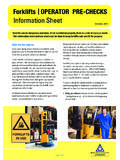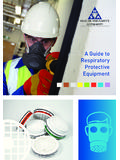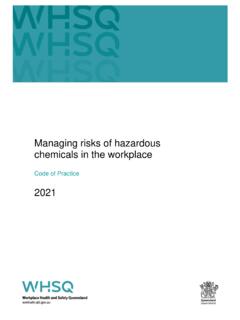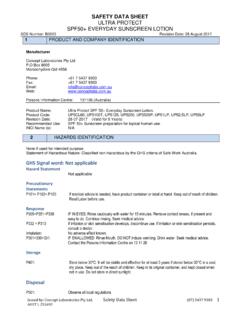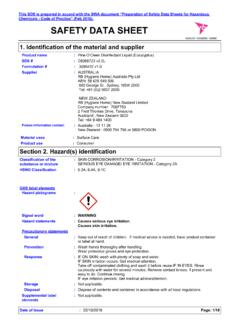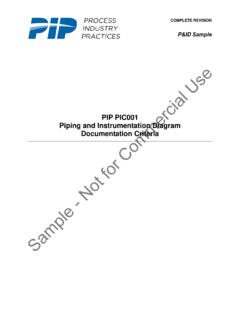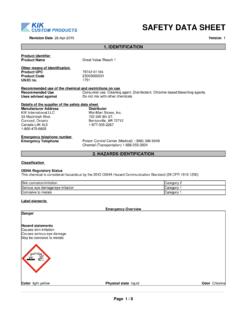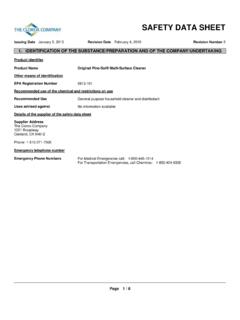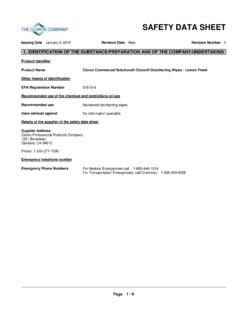Transcription of Chemicals - Health and Safety Authority
1 IntroductionThis section seeks to provide useful information to enable employers to manage chemical hazards in the workplace and comply with the chemical AgentsRegulations 2001 and other relevantchemical , almost every business uses in the cleanest, most modern office,employees are exposed routinely to inks,toners and adhesives not to mention a widerange of materials used in cleaning andmaintenance. Exposure to Chemicals in theworkplace can cause many different types ofharm, ranging from mild irritations to Chemicals and their associatedhazards in the workplace will bring real benefits to a business. In addition toimproved employee Safety and Health , costsavings can be achieved by limiting economic losses through effective workpractices such as correct storage, handling,use and disposal procedures.
2 Potential harmto the environment will also be what forms do Chemicals exist? Chemicals can exist in the form of:nSolids such as dusts, fumes, fibres ( dust, bitumen fumes and asbestosfibre).nLiquids, mists ( liquid bleach and mineral oil mist).nGases, vapours ( carbon monoxide gas and solventvapour).What Chemicals are hazardous?Any substance, in gas, liquid or solid form,which has the potential to cause harm, isreferred to as a hazardous or dangeroussubstance. Such substances include those:nBrought directly into the workplace and handled,stored and used for processing ( solvents, cleaning agents, glues, resins, paints).nGenerated by a process or work activity( fumes from welding/soldering,dustfrom machining of wood, flour dust,solvents).
3 NGenerated as waste or residue ( from soldering irons, carbon monoxide from exhausts).Substances can be considered hazardousnot only because of what they contain ( chemical ingredients) but because ofthe form or way in which they are used atthe addition to their effects on humanhealth, some Chemicals also presentphysical hazards such as the potential toignite or support combustion of other substances (oxidiser) and the potential toexplode. The physical, environmental andhuman hazards of a chemical substancemust be considered when conducting arisk assessment in the do Chemicals enter the body? In order for a chemical to become hazardous to a person s Health , it mustfirstcontactor enter the body and thechemical musthave some biological effecton the lists the four Workplace Health Toolkit to Assist Small BusinessesWhatarethe effects of exposure tohazardous substances?
4 Hazardous Chemicals are classifieddepending on howthey affect humanhealth,see Table maytarget specific organssuch as the eye, skin, blood, liver,kidneys, nervous system and eyes may also be a route of very small quantities of chemicalsin the workplace enter through themouth or the of the way the chemicalgets intothe body, once it is in it canbe distributed to anywhere in the bodybythe bloodstream. In this way, thechemicals can attack and harm organsthatare far away from the originalpointof effects are those that show upimmediately after a chemical exposureoccurs. A good example of an acuteeffect is the spillage of acid on the skin a chemical burn will occur effects are those that occurafter a significant amount of timepasses and usually are the result ofmultiple exposures over a period is a typical example of achronic effect because cancers causedby chemical exposures often do notshowup until twenty or more yearsafter the initial common examples of the effectsof hazardous Chemicals include.
5 NSkin irritation, dermatitis or skin cancer from frequent contact with to hands and eyes from contact with corrosive resulting from sensitisation to isocyanates in paints and disability from lung diseases following exposure to dusty environments ( exposure to respirable crystalline silicate).nDeath or injury from exposure to toxic fumes ( monoxide).nCancer causing death many years after firstexposureto carcinogens atwork ( ).Whatarethe factors affectingresponse to a substance?nDose:The amountof exposureto achemical is the single mostsignificantfactor of concern. There is a level of exposure for mostchemicals belowwhich no adverse effects are likely to be Workplace Health Toolkit to Assist Small BusinessesTable :How Chemicals Enter the BodyInhalationBreathing in contaminated air is the most common way that workplace Chemicals enter the bodySkin contactSome Chemicals , by direct or indirect contact, can damage the skin or pass through the skin into the bloodstreamIngestion Workplace Chemicals may be swallowed accidentally if food or hands are contaminated InjectionInjection can occur when a sharp object ( needle) punctures the skin and injects a chemical directly into the bloodstreamTable.
6 Effects of Chemicals on the BodyCarcinogenA chemical that causes or potentially causes cancer ( ,formaldehyde)CorrosiveA chemical thatcauses visible destruction of,or irreversible alterations in,living tissue by chemical action at the site of contact ( hydrochloric acid)IrritantA chemical that is not corrosive, but that causes reversibleinflammatory effects on living tissue at the site of contact( solvents)MutagenA chemical that damages chromosomes ( benzene)SensitiserA chemical that will cause an allergic reaction in a substantial number of exposed people ( isocyanates)TeratogenA chemical that causes birth defects ( thalidomide)What are Occupational Exposure LimitValues?Occupational Exposure Limit (OEL) Values for hazardous substances are importantinformation for risk assessment and exposure limit is the concentration either in parts per million (ppm) or mil-ligrams per meter cubed (mg/m3) of achemical in the workplace air to which mostpeople can be exposed withoutexperiencingharmful effects.
7 However, the values shouldnotbe taken as sharp dividing lines betweensafe and unsafe exposures. See Table fordetails of the OEL for absence of an exposure limit for a chemical substance does not imply it isharmless. It may be that there is not enoughinformation available to determine an exposure limit for that particular have only been set for a limited number of the substances currently used inthe workplace. Binding and indicative limitvalues are laid down in European has established its own nationalOELs, which include more substances thanthe directive. Employers must ensure thatthe exposure of the employees does notexceed the national HSA s Code of Practice for the Safety , Health and Welfare atWork (ChemicalAgents) Regulations 2001 (SI of 2001)gives the official listof OELs and is Occupational Exposure LimitValues : Chemicals vary widely in how toxic (poisonous) they to small amounts of highly toxic Chemicals can be a greater danger than exposure to large amounts of less toxic and frequency:One-time exposures that are of shortduration are of less concern than multiple exposures of longer duration, all other factors being , when there has been a chemical exposure, it is importantto know its duration and effects.
8 Synergism occurs when exposure to two or more Chemicals at a time results in Health effects that are greater thanthe sum of the effects of the individual Chemicals . For example,there is a much higher incidence of lung cancer resulting from occupational exposure to asbestos in smokers (compared with exposed non-smokers).nIndividual characteristics:Each person is unique. While there are many similarities in response to chemical exposures, responses mayvary dramatically among example,males andfemales can reactdifferently and special concern is afforded individuals are allergic or hypersensitiveto certain are hazard labels?All substances and preparations that areclassified as dangerous under theClassification, Packaging and Labelling(CPL) Regulations require a hazard label is the first and often the onlyinformation on the hazards of a chemicalthat reaches the end user.
9 The rules forclassification and labelling have been inplace for many years. They are now set tobe replaced over a phased period by anewsingle direct-acting regulationknown as CLP , which covers both substances and mixtures (previouslypreparations).CLP will be fully operational by 2015. Theclassification and labelling principles willremain the same with the most notabledifference for the end user being thechange in shape and colour of the symbolalong with some new global terminology,see Table Health Toolkit to Assist Small BusinessesTable :OEL for the chemical AcetoneSubstanceEinecs Exposure Limit Value(8 hour reference period)Acetone200-662-67-64-1500 ppm or 1210 mg/m32 Table :Comparing Current CPL and New CLP RegulationsCPLCLPS ymbol Pictogram Risk phraseHazard statementSafety phrasePrecautionary statementPreparationMixtureIndication of Signal word danger (Danger/Warning)( Irritant)Annex IAnnex VIDangerousHazardousp!
10 Chemicals to make a risk describes the hazards each chemicalpresents, as well as providing information on handling, storage,disposal, control measures and emergency measures in case of SDS must contain information setout under sixteen fixed headings (seeFigure ). Some may appear complicated but you can find the mostimportant information under the following sections:nSection 2 describes the hazards to human Health and the environment associated with the use of the will hazard labels change underthe new CLP regulations?Table lists the information contained on the CPL and CLP hazardlabels for acetone, highlighting the keychanges under the new is a Safety data Sheet (SDS)?Suppliers of Chemicals must provide anup-to-date Safety data Sheet (SDS) if asubstance or preparation is dangerousfor supply.

